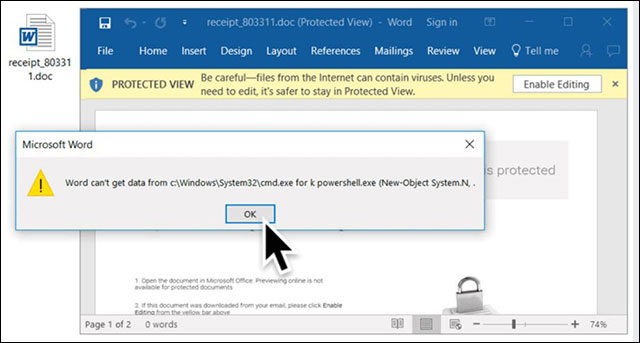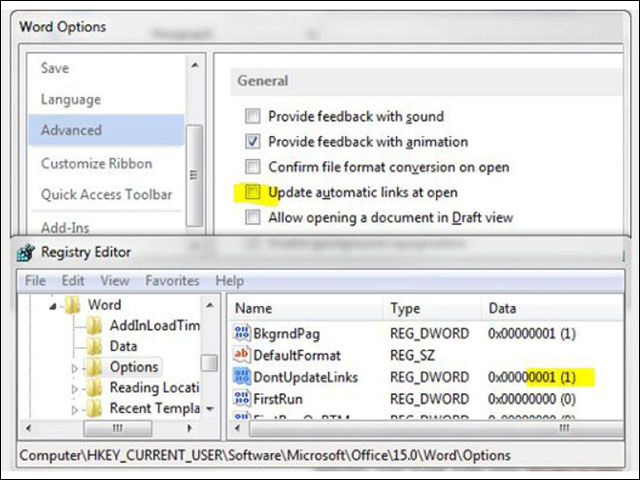The unpatched Microsoft Word DDE vulnerability is exploited in a massive malware attack
A new attack method that exploits the Microsoft Office integration feature has been discovered being used for malware distribution campaigns.
Quantrimang reported on the Microsoft Office feature called Dynamic Data Exchange (DDE) that allows malicious code execution without the need to turn on Macros or affect memory. This is the protocol that Microsoft uses to allow 2 applications to share the same data, used on MS Excel, MS Word, Quattro Pro and Visual Basic to share data once and continue to exchange when updating .
See also: Features available on MS Office allow malware to enter without turning on the macro
Exploiting with DDE will not show warnings to users but only ask if they want to execute the application, and even this popup can be syntactically modified.
As soon as details of the DDE attack technique were announced, Cisco's Talos research group reported an attack campaign using this technique aimed at several organizations with in-house remote access Trojan names. DNSMessenger.
Necurs Botnets use DDE attacks to distribute ransomware
According to the SANS ISC, Necurs Botnet - malware currently controls more than 6 million infected computers worldwide and sends millions of emails - used to distribute ransomware Locky and TrickBot banking trojans, using Word files and exploiting them thoroughly. DDE art.
Locky had previously used macro traps on MS Office files but now updated Nercus Botnet to spread malware over DDE and hijack victims' screen shots.
'Downloader now has the ability to collect the victim's parameters. It captures the screen shot and sends it to the server, and details the error when the downloader fails. '
Malware Hancitor uses DDE attack techniques
Another malware spam campaign was discovered as Hancitor (aka Chanitor and Tordal) using MS Office's DDE. This is a downloader that installs malicious payloads such as bank trojans, malware and ransomware onto infected machines and is often sent as MS Office files using macros in phishing emails.

Malware exploits attack techniques via DDE
How to protect yourself from DDE attacks?
Because DDE is a legitimate feature of Microsoft, most anti-virus software will not warn or block MS Office files and no one can give a patch.

Un-automatically update on Options
You can protect yourself by disabling the option to 'auto-update links when opening' on Office in Word > Select File > Options > Advanced and navigate to the General section , uncheck 'Update Automatic Links at Open'.
See also: Google: Dangerous for users when Microsoft does not patch Windows the same way on the OS
You should read it
- Hackers are using new Microsoft Office vulnerabilities to distribute malware
- Detects 'long-standing' security vulnerabilities in Microsoft Office
- 4 things to expect in Microsoft Office 15
- Office 2013 SP1 will be released early next year
- How to block ads on WPS Office
- Office security with Microsoft Office (Part I)
- Microsoft Office iOS app has an important update, supports downloading PDF files for offline use
- Microsoft Office 16 exposes details in the new series
May be interested
- How to Protect Yourself from the Latest WordPress Malware Attack
 as one of the most popular website building tools in the world, wordpress is once again a target for malware.
as one of the most popular website building tools in the world, wordpress is once again a target for malware. - Detects 'long-standing' security vulnerabilities in Microsoft Office
 security firm bkav on july 22 has warned that a microsoft office vulnerability has been quietly exploited since 2009.
security firm bkav on july 22 has warned that a microsoft office vulnerability has been quietly exploited since 2009. - Detects a vulnerability that threatens all Windows computers shipped from 2012 up to now
 security researchers have found a vulnerability in the microsoft windows platform binary table (wpbt). this vulnerability can be exploited by hackers to install rootkits on all windows computers shipped from 2012 to the present.
security researchers have found a vulnerability in the microsoft windows platform binary table (wpbt). this vulnerability can be exploited by hackers to install rootkits on all windows computers shipped from 2012 to the present. - One more unpatched vulnerability on Apple M1 chip, users remain unaffected
 this is the second unpatched vulnerability discovered on the apple m1 chip and as usual apple says it does not affect users.
this is the second unpatched vulnerability discovered on the apple m1 chip and as usual apple says it does not affect users. - Microsoft patched a critical vulnerability in Windows
 yesterday microsoft patched three vulnerabilities in windows, one of which could be exploited by attacks that trick users into accessing malicious websites.
yesterday microsoft patched three vulnerabilities in windows, one of which could be exploited by attacks that trick users into accessing malicious websites. - Patches of dangerous vulnerabilities being exploited by hackers contain dangerous holes and then continue to be exploited by hackers
 not long after the log4j vulnerability was discovered, the patch was released. however, the irony is that this patch has holes.
not long after the log4j vulnerability was discovered, the patch was released. however, the irony is that this patch has holes. - Microsoft silently patched the KRACK WPA2 security hole
 while other vendors are trying to release an update to patch the krack attack vulnerability yesterday, microsoft quietly corrected the problem in a patch last tuesday.
while other vendors are trying to release an update to patch the krack attack vulnerability yesterday, microsoft quietly corrected the problem in a patch last tuesday. - This new ransomware is threatening unpatched Microsoft Exchange servers
 cybersecurity researchers have witnessed a never-before-seen series of windows ransomware that can infect an unpatched microsoft exchange email server and the network of a us-based hotel business.
cybersecurity researchers have witnessed a never-before-seen series of windows ransomware that can infect an unpatched microsoft exchange email server and the network of a us-based hotel business. - Serious warning about Windows WMF vulnerability
 symantec announced an alert 3 for windows' unpatched wmf security vulnerability. this is the second time in the last 18 months an alarm has appeared. because the official patch will not be available before january 10, 2006, for n & ecir
symantec announced an alert 3 for windows' unpatched wmf security vulnerability. this is the second time in the last 18 months an alarm has appeared. because the official patch will not be available before january 10, 2006, for n & ecir - Use Nepenthes Honeypots to detect common malware
 over the past few years, a large number of serious bugs in the windows operating system have been discovered. like ms03-026, exploited and dispersed by the blaster worm in 2003; or lately is mocbot / wargbot worm, exploiting the ms06-040 vulnerability from
over the past few years, a large number of serious bugs in the windows operating system have been discovered. like ms03-026, exploited and dispersed by the blaster worm in 2003; or lately is mocbot / wargbot worm, exploiting the ms06-040 vulnerability from










 LokiBot - bank trojan on Android turns into ransomware when you try to delete it
LokiBot - bank trojan on Android turns into ransomware when you try to delete it Bad Rabbit - Petya's new ransomware spreads throughout Eastern Europe
Bad Rabbit - Petya's new ransomware spreads throughout Eastern Europe DUHK attacks allow hackers to obtain encryption keys for VPN and web browsing sessions
DUHK attacks allow hackers to obtain encryption keys for VPN and web browsing sessions Roboto Font Condensed install malware on your computer
Roboto Font Condensed install malware on your computer Hacker Instagram offered to sell personal information of 6 million accounts on DoxaGram
Hacker Instagram offered to sell personal information of 6 million accounts on DoxaGram MongoDB malicious code attacks more than 26,000 victims in a week
MongoDB malicious code attacks more than 26,000 victims in a week